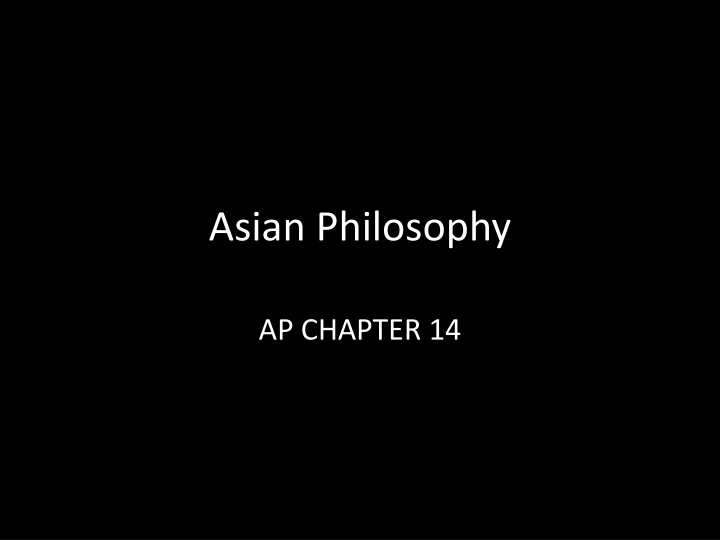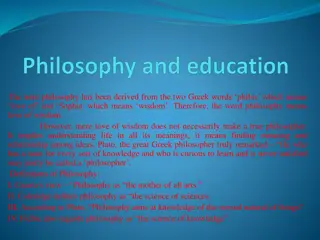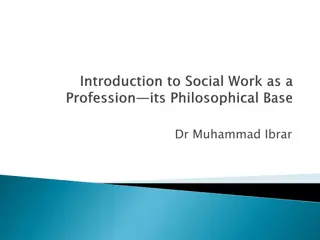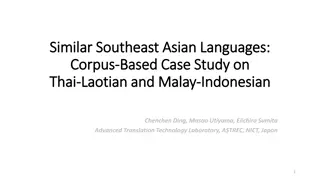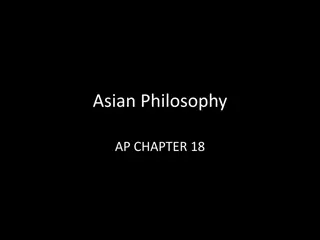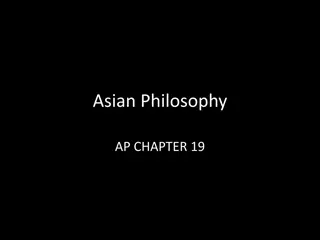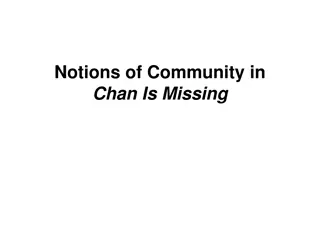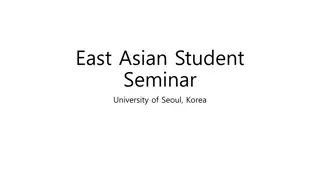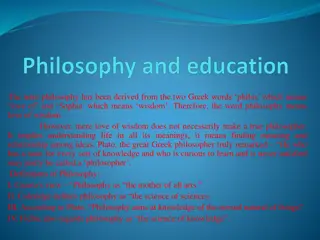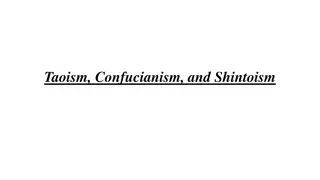East Asian Philosophy: From Confucianism to Daoism and Mohism
East Asian Philosophy, encompassing Chinese, Japanese, Vietnamese, and Korean traditions, is shaped by pillars like Confucianism, Daoism, and Buddhism. This philosophical landscape evolved from a rich tapestry of ideas, including Pre-Confucian China's historical context, the teachings of Confucius, Laozi's Daoism, Mozi's Mohism, and Gongsun Long's School of Names. Each school of thought offers unique insights into moral cultivation, following nature, promoting welfare, and exploring knowledge for its own sake.
Download Presentation

Please find below an Image/Link to download the presentation.
The content on the website is provided AS IS for your information and personal use only. It may not be sold, licensed, or shared on other websites without obtaining consent from the author.If you encounter any issues during the download, it is possible that the publisher has removed the file from their server.
You are allowed to download the files provided on this website for personal or commercial use, subject to the condition that they are used lawfully. All files are the property of their respective owners.
The content on the website is provided AS IS for your information and personal use only. It may not be sold, licensed, or shared on other websites without obtaining consent from the author.
E N D
Presentation Transcript
Asian Philosophy AP CHAPTER 14
East Asian Philosophy East Asian Philosophy includes Chinese, Japanese, Vietnamese and Korean Philosophy East Asian Philosophy has distinct strands of philosophy within it from what is found in Classical Indian philosophy. Although some of classical Indian philosophy made its way to China and from there to other parts of East Asia, not all of classical Indian philosophy was adopted or assimilated. East Asian Philosophy Central Asian or Indian Philosophy
East Asian Philosophy East Asian Philosophy is largely shaped by three pillars of Asian philosophy: Chinese Confucianism Chinese Daoism Indian Buddhism There are various ways in which these three strands can be and have been woven together or separated.
Pre-Confucian China Prior to Confucius (prior to 551 BCE): Zhou Dynasty Flourished. It brought peace to China for a short time. However, there were constant wars which resulted in the shifting of power. By 770 BCE the groups that were at war killed the Zhou king. Confucian philosophy arose from the context of an unstable China where many groups had been at war.
Confucius 6thcentury BCE School of thought: Confucianism Main work: Analects Core teaching: by developing human nature REN through a process of moral self cultivation a person s life can be improved, and they can reach human perfection.
Laozi 6thcentury BCE School of thought: Daoism Major Works Daodejing. Core teaching: following nature is a way that one can come to improve and cultivate themselves.
Mozi 5th century BCE School of thought: Mohism Core teaching: promote general welfare and remove evil. Goodness is measured by its utility in gaining happiness.
Gongsun Long 4thcentury BCE School of thought: School of Names Core theoretical exploration: Knowledge for its own sake. The nature of logic.
Yinyang philosophy 4thBCE School of thought: Philosophy of Change The Yijing (I-Ching) Originally a divination manual Core idea: there is a single primal force qi, which has two forces yin and yang that come together to produce change.
Han Fei 3rdBCE School of thought: Legalism Core teaching: people are naturally prone to do what is wrong. Laws are justified because they help the greater good by providing for a better human welfare. Opposed to Confucianism that proposes that humans are fundamentally good.
Synthesis: During the Han Dynasty (206BCE 220CE) there were attempts to synthesize the various schools. On one account the Dao produces yin and yang. On another account an attempt was made to combine Confucian, Daoist, Legalist, and Yin-Yang philosophy to find direct correlations between Heaven, Earth, and Humanity.
Buddhism, Huayan, and Tiantai Only Mahayana Buddhism becomes popular because it can be made consistent with Confucianism and Daoism. Within Mahayana we find the following movements from India to China Madhyamaka Buddhism Huayan Yogacara Buddhism Tiantai
Chinese Contributions to Buddhism A contribution to Buddhism made by Chinese thinkers was to change the fundamentally negative idea of emptiness into a positive idea. For some Chinese Buddhists: Emptiness the denial of permanence or separateness. Rather: Emptiness = omnipresence of Buddha-Hood
Chinese Contributions to Buddhism Another contribution to Buddhism made by Chinese thinkers was to offer a reinterpretation of interdependent arising. For many Indian Buddhists interdependent arising was the denial of the idea that things have singular causes. For some Chinese Buddhists interdependent arising was associated with the total causation where all elements were seen to be real. Grand Harmony was sought because each entity is such that part of its opposite is part of it.
Pure Land and Chan Buddhism Two additional schools that were influenced by Madhyamaka and Yogacara are: Chan and Pure Land. The Chan school began as a school of meditation. The goal is to achieve the enlightened mark by seeing all things in their true nature. This is done by training the mind to see directly through mindfulness. Pure Land (jingtu) saw efforts of meditation as too difficult. They focused instead on the role of compassion. Buddhism remains in China from the 4th century BCE forward.
Korean Philosophy Korean Philosophy includes both Confucianism and Buddhism. Buddhism was popularized by the monk Wonhyo (617-686). Confucianism later replaced Buddhism around the 13thcentury. Korean thinkers, such as T oegye (1501-1570) and Yulgok (1536-1584) both made contributions to Confucian thought. A core debate they had was over the nature of virtue and emotions in self-cultivation and moral behavior.
Buddhism in Japanese Philosophy Buddhism entered Japan through China and Korea. Japanese Buddhism engages the indigenous Shinto tradition. Kukai (774-835) introduced the Shingon School of Tantric Buddhism. Saicho (767-822) established the Tendai tradition. Honen (1133-1212) established the Pure Land (Jodo) School. Shinran (1173-1262) established the True Pure land School. Eisai (1141-1215) introduces the Rinzai form of Zen Buddhism. Dogen (1200 1253) establishes Soto Zen.
The Rise of Neo-Confucianism Confucianism as a critique of Buddhism: (i) Emphasis on overcoming death and suffering is selfish. (ii) Renouncing family and society is wrong. (iii) Emptiness of everything makes everything unreal, this leads to a questioning of value. Neo-Confucianism is an attempt to build a superior Chinese philosophy to that produced by Indian Buddhism. The rise of Neo-Confucianism can be traced to Cheng Hao and Cheng yi from the 11thcentury.
Characteristics of East Asian Philosophy Commonality: Self-Transformation Commonality: Aim to reach human perfection Difference: Path to reach human perfection Dao = follow nature; Confucian = follow Ren and social virtue Human perfection has a double aspect: (i) It involves an inner perfection that is reflected in the peace and contentment of the individual and in the harmony of her relationships with others and nature. (ii) It involves excellence in external conduct of life, the ability to live well practically, dignifying the social context of one s ordinary day to day existence. We aim for sageliness without kingliness.
Characteristics of East Asian Philosophy Because human perfection is a basic concern, people come first. Emphasis on human perfection leads to self-cultivation. Self-cultivation leads to practicing for perfection. The general method is one of inclusiveness. The goal is to combine partially true views, rather than to exclude other views as simply being false. Philosophical arguments are less deductive and more metaphorical or analogical. There is a tendency to harmonize and synthesize opposing views.
